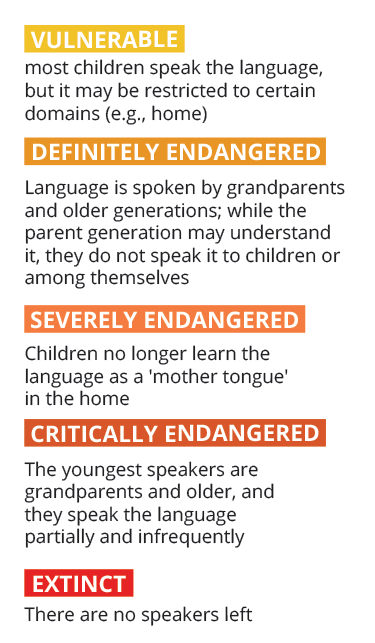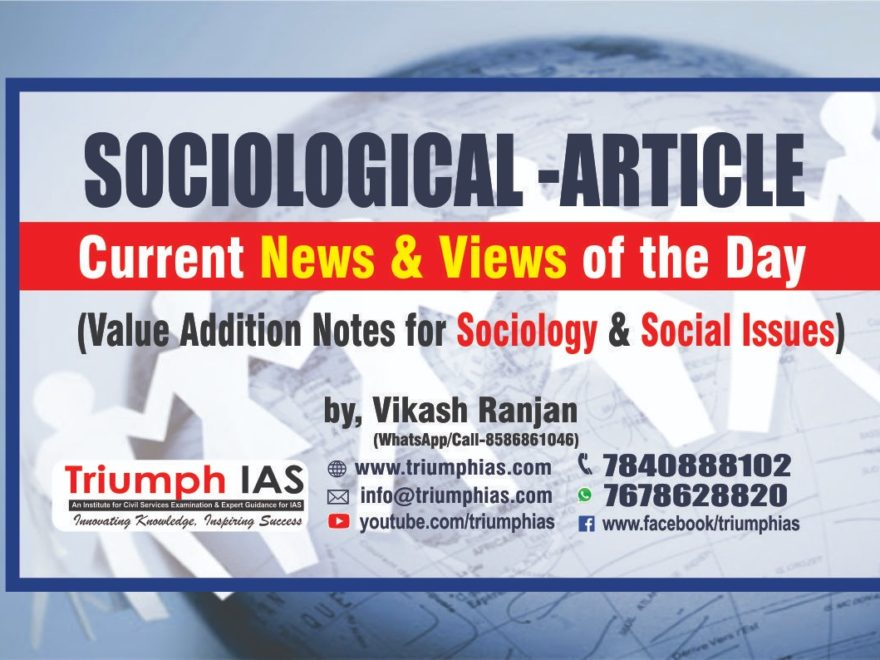Tribal languages in India face extinction threat
Relevance: Tribal communities in India: (a) Definitional problems. (b) Geographical spread. (c) Colonial policies and tribes. (d) Issues of integration and autonomy.
CONTEXT
To lose these indigenous languages means losing huge human capital and rich cultural diversity.
Language is the only tool for expressing identity and culture as well as one of the greatest emblems of human diversity.
There are 7,000 living languages in the world and around 3,000 are considered as ‘endangered’. This means that almost half of the planet’s current linguistic diversity is under threat.
The situation in India is alarming. Some 197 languages are in various stages of endangerment in our country, more than any other country in the world. Ganesh N Devy, founder-director of the Bhasa Research and Publication Centre, Vadodara and Adivasi Academy at Tejgadh, Gujarat, said, “India may have lost 220 languages since 1961. There were 1,100 languages since 1961, based on the Census number of 1,652 mother tongues. Another 150 languages could vanish in the next 50 years.”

Linguistic expert Devy documented 780 living languages and claims that 400 of them are at risk of dying.
There are five tribal languages that are moving towards extinction in India. Linguist experts say that the most threatened language is Majhi in Sikkim. According to a research conducted by People’s Linguistic Survey of India, there are just four people who currently speak Majhi and all of them belong to the same family.
Similarly, the Mahali language in eastern India, Koro in Arunachal Pradesh, Sidi in Gujarat and Dimasa in Assam are facing extinction. Until recently, UNESCO has put Asur, Birhor and Korwa in its list of the world’s endangered languages with Birhor being categorised as ‘Critically Endangered’, with just 2,000 speakers left.
According to UNESCO, any language that is spoken by less than 10,000 people is potentially endangered. In India, after the 1971 census, the government decided that any language spoken by less than 10,000 people need not be included in the official list of languages.
From 1971 onwards, the Census has been counting only of those languages that have more than 10,000 speakers. It resulted in a decline in the list of languages to 108 languages in the 1971 Census, as against 1,652 a decade ago.
Tribal languages are a treasure trove of knowledge about a region’s flora, fauna and medicinal plants. Usually, this information is passed from generation to generation. However, when a language declines, that knowledge system is completely gone. With the loss of language comes the loss of everything in culture and loss of solidarity, the loss of Man himself.
While the danger of extinction looms large over some languages, many other languages have been thriving. For example, Gondi (spoken in Odisha, Chhattisgarh, Maharashtra), Bhili (Maharashtra, Rajasthan, Gujarat), Mizo (Mizoram), Garo and Khasi (Meghalaya) and Kokborok (Tripura) are showing an upward trend because educated people in these communities have started using these languages for writing.
“They publish poems, write plays and perform them. In some of the languages, even films are being made. For instance, they have started making films in Gondi. The Bhojpuri film industry is prospering. The language itself is growing, probably the fastest in the country,” Devy said.
Two major tribal languages that are included in the Eighth Schedule, namely Bodo and Santali, have also shown declines, though not negative growth. The number of Bodo speakers in Assam declined to 4.53 per cent of the total population in 2011, from 4.86 per cent in 2001. It shows a total decadal percentage increase of 9.81. On the other hand, Santali shows a total decadal percentage increase of 13.89.
Situation in Odisha: Case study
Odisha has one of the most diverse tribal populations in India, with 62 tribes, including 13 particularly vulnerable tribal groups (PVTGs). There are 21 tribal languages and 74 dialects which immensely contribute to the linguistic diversity of the state.
Only six tribal languages — Santali, Ho, Soura, Munda and Kui — have a written script. Santali has already been included in the Eighth Schedule. The state government adopted the Multi-Lingual Education (MLE) programme in 2006 to address the issues of language barriers faced by tribal children.
The Odisha government has appointed 3,385 tribal language teachers for the MLE programme. Additionally, the state government published dictionaries for 20 tribal languages. These not only enable scholars and enthusiasts to learn languages but also produce literature — ultimately conserving the existing ones.
In 2018, the state proposed inclusion of three major languages — Ho, Mundari and Bhumji — in the Eighth Schedule of the Constitution. There are around a million Ho speakers in Odisha, 0.6 million Mundari speakers and 0.3 million Bhumij speakers.
However, the various initiatives undertaken by the Odisha government to promote tribal languages in schools has not yielded the desired results. The state government has indeed produced primers in several languages for the initial primary grades.
But in most cases, the approach was limited to the translation and publication of textbooks or readers. Besides, while Santali was included in the Eighth Schedule of the Indian Constitution since 2003, Odisha has not yet included it in MIL and the Odisha Administrative Services.
Joy Daniel Pradhan, a Delhi-based development practitioner and an expert on tribal development issues said, “Components like teacher training, regular academic follow-up and comprehensive evaluation were largely ignored by the state government.”
If urgent steps are not taken, it is likely to affect the learning of tribal children in the classroom, since learning depends on continuous interest and eternal vigilance, pointed out Daniel.
On a similar note, Srinibas Das, a development professional working with tribal communities in the Kalahandi-Balangir-Koraput region on issues like tribal education, health and livelihood, said, “In many tribal-dominated states, MLE has been implemented without proper planning and coordination. Poor training of language teachers and lack of teaching learning materials are pressing challenges. Language teachers are the key players to ensure the success of the MLE programme that aims to transition tribal children into the mainstream education system.”
Is Mother Tongue Based Multi-Lingual Education a solution?
Mother Tongue Based Multi-Lingual Education (MTBMLE) could play a key role in preserving tribal languages, claim linguistic experts. Ignoring mother tongue- based intervention in early childhood for tribal children could potentially impede the early childhood learning process. There are some civil society organisations in Odisha that have demonstrated promising models of the MTBMLE education system.
Take for instance, the Kalinga Institute of Social Sciences (KISS), the largest residential institute in the world providing free and quality education from kindergarten to post-graduation for tribal children.
KISS has been filing up the gap in the learning process among tribal children by implementing a robust MTBMLE approach. It has introduced ‘Transition Curriculum’ — an innovative pedagogic initiative, teaching and learning tools in 10 tribal dialects of the state.
The approach helps bridge the gap between home and school languages and validates the child’s home culture and traditional knowledge, thus enabling better learning.
The MTBLE not only improves the quality of education but also makes holistic mainstream education more accessible for tribal children enrolled in KISS.
MTBMLE approach had developed significant cognitive reasoning skills among tribal children, enabling them to operate equally in different languages.
The MTBMLE approach facilitates the learning of second and third languages. Building a strong L1 foundation, the student is then bridged to their second language (L2) by providing strong training in their listening, speaking, reading and writing skills.
Way forward
Tribal languages should be endorsed through innovative, cultural and entertainment programmes, suggest linguistic experts. For example, in February this year, a local community radio channel called ‘Asur Mobile Radio’ in Jharkhand launched cultural programmes in the Asur language, which has only 7,000-8,000 speakers.
The Asur community is among the few PVTGs in the state to preserve their language. The Asur language features in the UNESCO list of ‘definitely endangered’ languages.
Manoj Lakra, a Jharkhand-based tribal development expert said, The Asur community started popularising the language in their area. This has significantly aided the revival of the dying language.
According to Lakra, local civil society organisations and cultural institutions should make dramas and films in native tribal languages. This will ensure a wider outreach and encourage the younger lot to preserve and respect their language.
There is a need to promote tribal languages as a medium of communication and education in tribal-dominated districts. It can significantly reduce the communication gap and school dropout rate.
It is important to integrate indigenous knowledge systems alongside modern sciences in the curriculum of schools. Tribal languages are fundamental to understand the world we live in, our origin, the roots that we all came from and what humans are capable of.
Therefore, it is high time for others to appreciate the important contribution of tribal languages in enriching the world’s rich cultural and linguistic diversity.
For more such notes, Articles, News & Views Join our Telegram Channel.
Click the link below to see the details about the UPSC –Civils courses offered by Triumph IAS. https://triumphias.com/pages-all-courses.php

